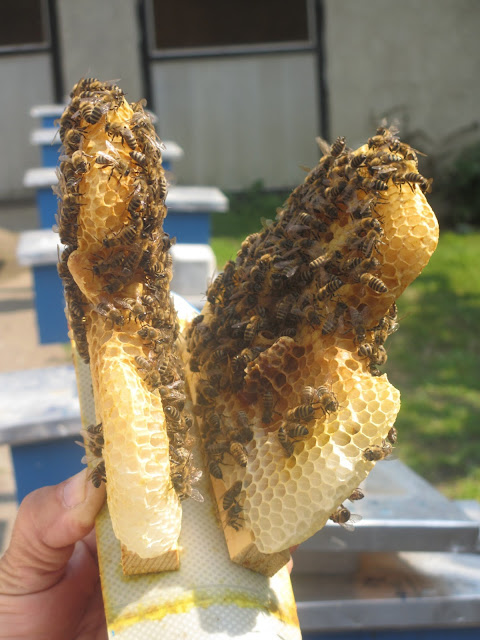 |
| The Flag of Bosnia-Herzegovina, which was assigned by the Council of Europe. |
 |
| Driving west from Belgrade, you cross the Drina River and enter into eastern Bosnia. Yes, most of us think of it solely in terms of the war during the 1990's. But, Bosnia, up there with Montenegro, was my favorite stop in our tour of countries that were born of the ex-Yugoslavia. The beauty of the countryside is as good as anywhere in Italy and other parts of western Europe. |
|
 |
| Before I get to the more serious parts of this post, Brian and I stopped when we saw this beekeeper and his son. This is why I have Brian along....to see things like this and actually stop and engage!! |
 |
| Can you spot the queen bee? |
 |
| Standing in Bosnia, looking into Serbia. Could be Switzerland, eh? |
 |
| Brian and I could have taken a more direct route between Belgrade and our destination, Sarajevo, but I wanted to visit Srebrenica, which is this town I heard about so much but knew little about. This is what I learned..... |

Background...as always. Bosnia (I will always mean Bosnia-Herzegovina) declared its independence from Yugoslavia, but it was a country that had a pretty even split between Bosniaks (Muslim), Serbs (Orthodox) and Croats (Catholic). When the country declared independence, the Bosnian Serbs (the first is always the political and the second is the religious affiliation) decided to become their own country within Bosnia. The Bosnia Serbs, lead by Radovan Karadzic and his military leader, Radko Mladic, were well armed and terrorized the Bosniaks, most famously in the Siege of Sarajevo (future post). But one of the MOST horrific things the Bosnia Serbs did was follow through on their pledge of ethnic cleansing of the areas they deemed to be Serbian territory. This is where we come to the town of Srebrenica, which was an enclave of Muslims in eastern Bosnia, which is predominantly Serbian. The Serbians wanted complete geographic continuity. So in towns throughout eastern Bosnia, they rounded up non-Serbs and forced them out. The most horrific case was in the Srebrenica, which is the bottom half of the middle tail that sticks out of Bosnia in the east. By 1993, as towns throughout the area were "cleansed" the Muslims gathered in Srebrenica. The United Nations declared the town a "safe zone" and sent peacekeeping forces. But the Serbs did not demilitarize and they made it more and more difficult for aid to get through. Then, in early June 1995, the Serbs take over Srebrenica. On July 11th, 1995, Muslim refugees were in a compound in the town of Potocari, about 5 km north of town. And on June 12th, boys and men were separated and the massacre of some 8,000 Bosniak men and boys had begun. Some men decided to take their lives into their own hands and left to compound and hiked out, trying to make it to another safe area. Some of these men were in the hills for months and finally exited after the Dayton Peace Accords were signed in November 1995.
 |
| A minaret in the town of Srebrenica. |
 |
| A house that still has holes from the gunshots from during the siege on Srebrenica. |
 |
| The hills around Srebrenica |
 |
| On the site of the Potocari refugee camp, now stands the site of the memorial to the victims of the Srebrenica Massacre. |
 |
| Most of the victims were buried in mass graves. As the bodies are exhumed, and identified, they are buried here and given a headstone. |
 |
| This headstone was different from all others. A google search revealed that this man, a Bosnian Croat (therefore Catholic) was a resident of Srebrenica and stayed in town through the entire siege with his friends and neighbors. He was also massacred. His family wanted him buried here at the memorial. |
 |
| The names of each known victim is inscribed in a memorial. Two entire columns here with males with the same surname. The small name between the surname and given name is the name of the father. |
 |
| On the grounds of the memorial is a place for visitors to answer the call to prayer. |
 |
| We ran into this group who were pointing out names and then went to some tombstones. When they came back I asked what their connection to this memorial was. |
 |
| This man was a former resident, probably not much older than me, of the Srebrenica area and lived here in the 1990's. He's a Bosniak. He escaped the massacre and was sponsored by his brother who was living in the United States and emigrated to Connecticut as a refugee. He brought his son back to see his former home and to visit the graves of his three uncles who were victims of the massacre. He spoke of his incredible anger and frustration at the lack of help the people of Srebrenica were given and how the world basically gave up on them. He just threw up his hands a lot. This was an incredible moment, to talk with this man and the other members of his family. |
 |
| Three of the Buric's were my friend's uncles. |
If you want to know more about the genocide and watch some videos that are just so sad, click on
Srebrenica Genocide Blog.






























































